When my son was in grade school, he begged to plant a vegetable garden. I thought it was a great idea; it would get him outdoors and get his hands in the dirt. I diligently tilled a patch of our lawn. We planted tomatoes, lettuce, string beans and green peppers. There was only one problem: my kid was a carnivore and quickly lost interest in our homegrown vegetarian fare.
The next summer, the weeds were chest high, so we turned the garden back to grass. In the process, I discovered stringy vine-like roots, which I yanked out with the rest of the tangled mess.
“I hope you were wearing a long-sleeved shirt,” said my husband when I mentioned the roots. “That might be poison ivy.”
“In our lawn?” I replied doubtfully. “I’m not allergic to it anyway.”
A week later, itchy, oozing blisters erupted all over my arms, torso and neck. The plant’s roots, which had laid dormant under our lawn, beaten back by the mower, had given me my first case of “urushiol-induced contact dermatitis”.
Until the rash disappeared, I was the family pariah. No one wanted to get near me for fear of contracting my malady. They needn’t have worried. I would only have been contagious if I had failed to shower after my anti-gardening exploits. (The blisters contain only water.)
How you get the rash without touching the plant is only one misconception about this toxic plant. There are more:
-
Myth #1: Poison ivy and its cousins, poison oak and poison sumac, are the only poison plants in the United States that cause an itchy rash.
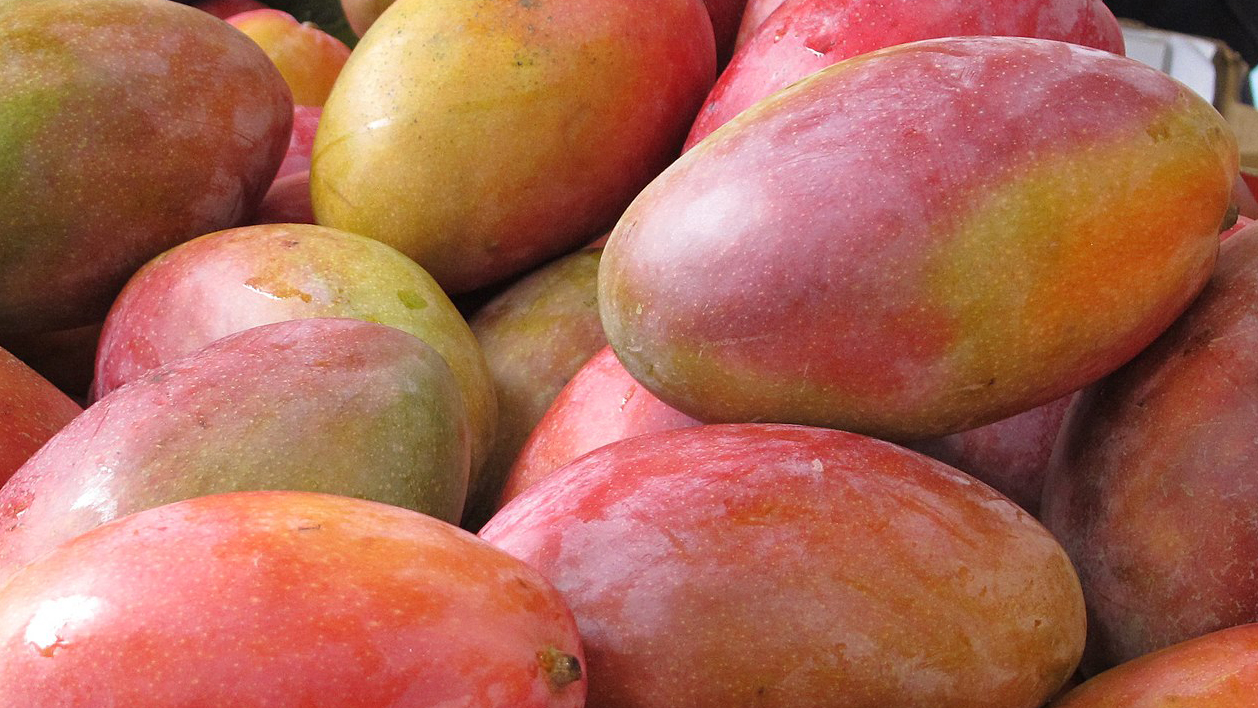
Mangoes in a farmer’s market. By Snapdragon66 [CC BY-SA 4.0] from Wikimedia Commons Poison ivy grows in every state except for Alaska and Hawaii, but you can still get a similar rash in Hawaii if you rub mango skins against your body. You can also get blisters on your lips if you eat the sweet fruit directly off the rind.
Poison ivy and mangoes belong to the Anacardiaceae family. Other plants in this family, such as cashews, also produce a rash-inducing oil. All cashew nuts are shelled and cooked before they arrive at the grocery store, which neutralizes their rash-inducing toxin. Unfortunately, the urushiol oil in poison ivy is resistant to heat.
Interestingly, pistachios, another member of the Anacardiaceae family, doesn’t cause a rash.
-
Myth #2: Animals naturally avoid poison ivy because they sense it’s toxic to touch.
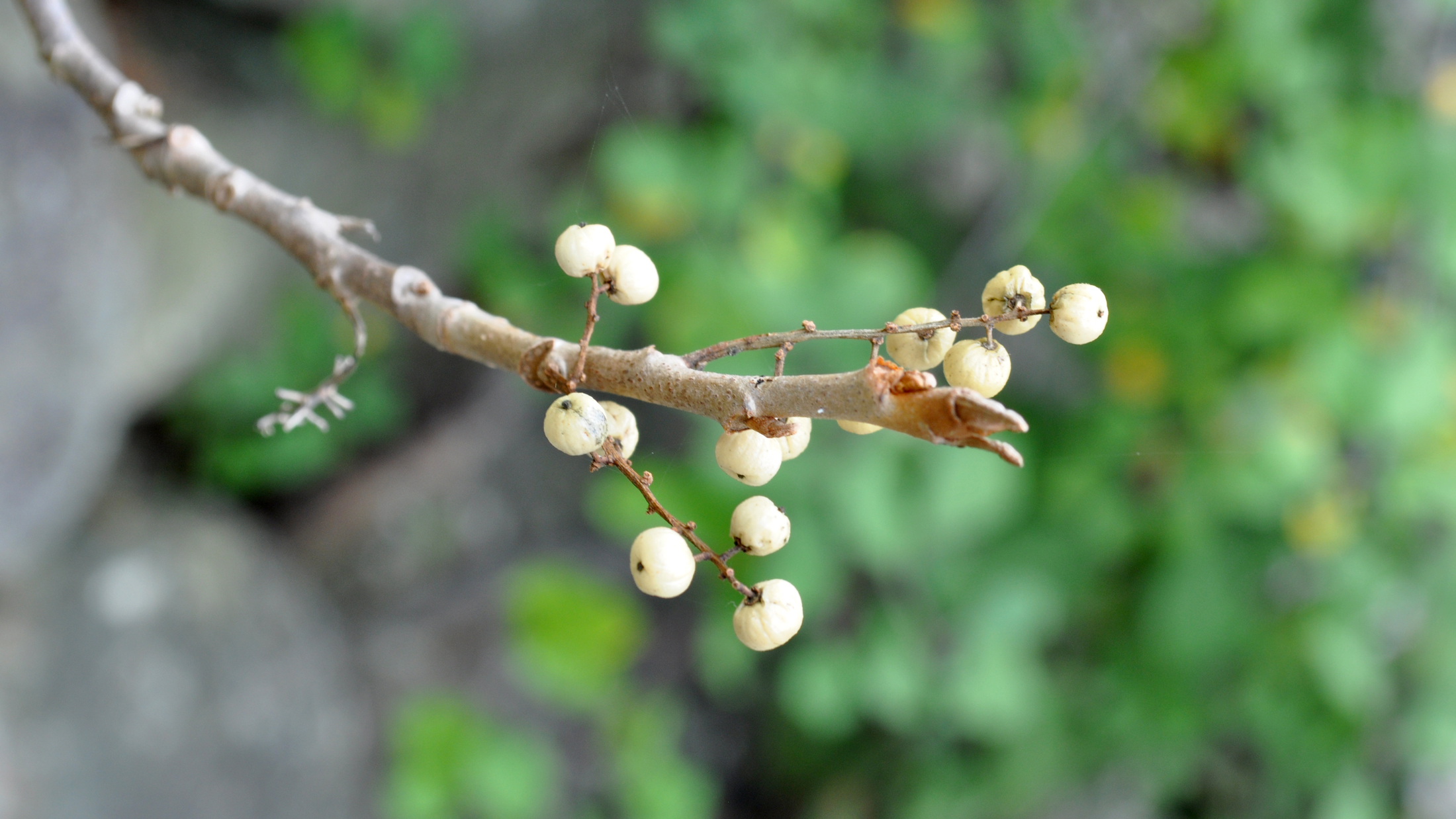
Poison ivy berries. Photo © Lisa Ballard Both mule deer and whitetail deer, who are primarily browsers, seek leafy plants, including poison ivy. According to the South Carolina Department of Natural Resources, birds, including catbirds, chickadees and wild turkeys, sup poison ivy’s smooth, white berries, particularly during the winter when food is scarcer. Black bears, wood rats, raccoons and muskrats also eat the plant’s stems and leaves, and toads hide under it.
Animals may not react to poison ivy, but they can give it to humans. This toxic weed flourishes in open woodlands, especially alongside openings, like footpaths, where it can get sunshine yet not get crushed by hiking boots. If you go hiking with your dog and he romps through a patch of poison ivy, then you pet your dog, your hands pick up the urushiol oil. Until you wash them, any bare skin on your body that you touch can get the rash, and any article of clothing or gear can transfer the itchy toxin to another part of your body or to someone else.
-
Myth #3: If you don’t see three leaves, it’s not poison ivy.
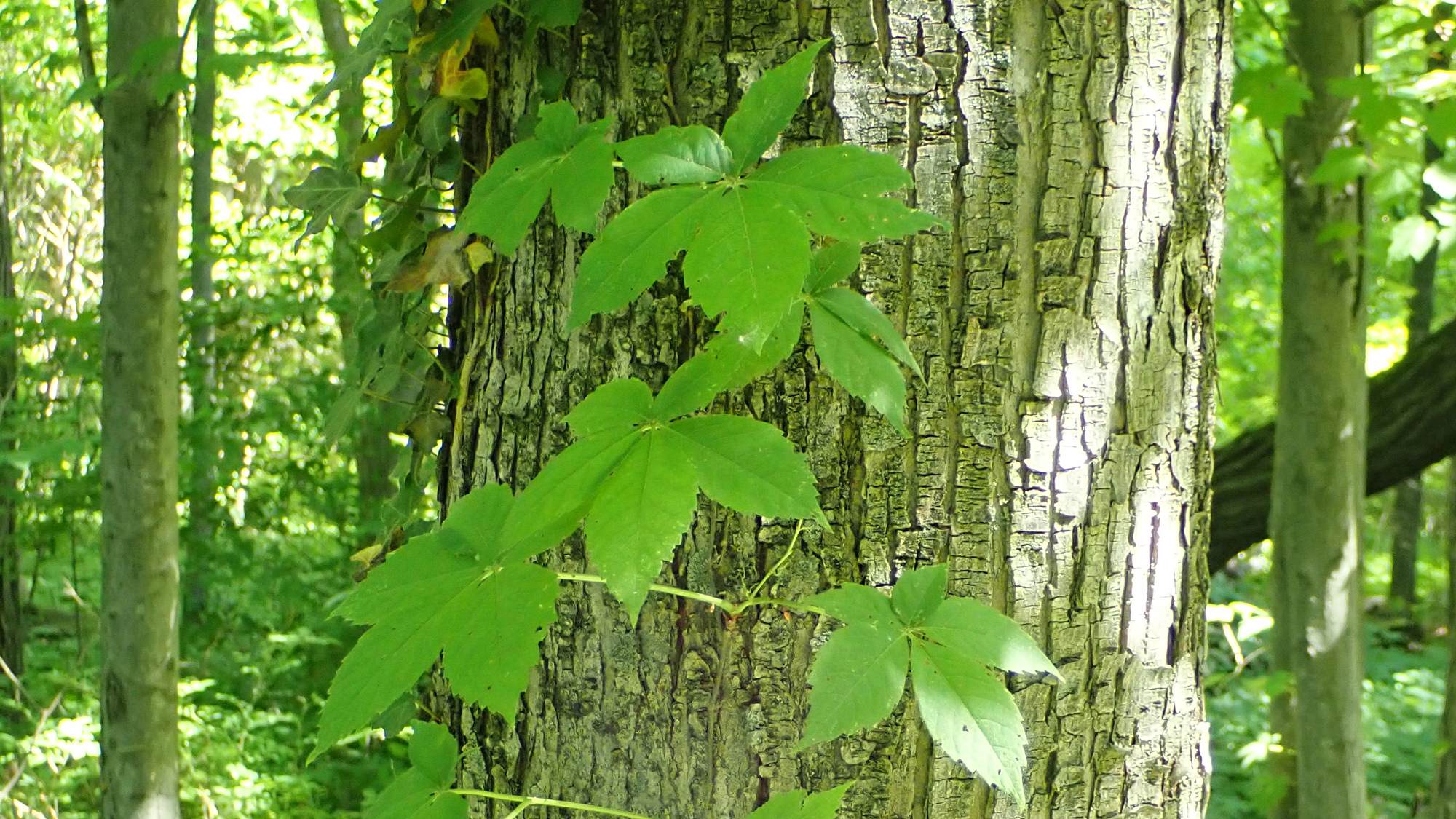
Virginia creeper vine. Photo © Lisa Ballard While the mantra, “leaves of three, let it be”, helps identify poison ivy, which has three toothed, heart- or almond-shaped leaves growing from one point on a stalk, every part of the plant can cause a reaction, including the stems, berries and roots as I inadvertently discovered.
When poison ivy first comes up in the spring, it looks dark red and glossy. The leaves quickly turn the same green as other leaves in a deciduous forest, but if you look closely, there may be tinges of red where the leaves come together. Then, in the fall, they put on a showy display of reds and yellows on par with any maple tree.
This tenacious plant can grow as a stand-alone perennial, shrub, ground cover or vine. As a vine, it sprouts thousands of brown hairs that grasp the bark of its host tree. As it climbs toward the canopy and matures, its stem gets woodier and increases in diameter, up to several inches thick, as if a second tree has grown up hugging the original one.
People often confuse Virginia creeper with poison ivy, but Virginia creeper has five leaves, not three. You don’t want to bathe in Virginia creeper either. Its sap can also cause an annoying rash.
-
Myth #4: I’m not allergic to poison ivy.
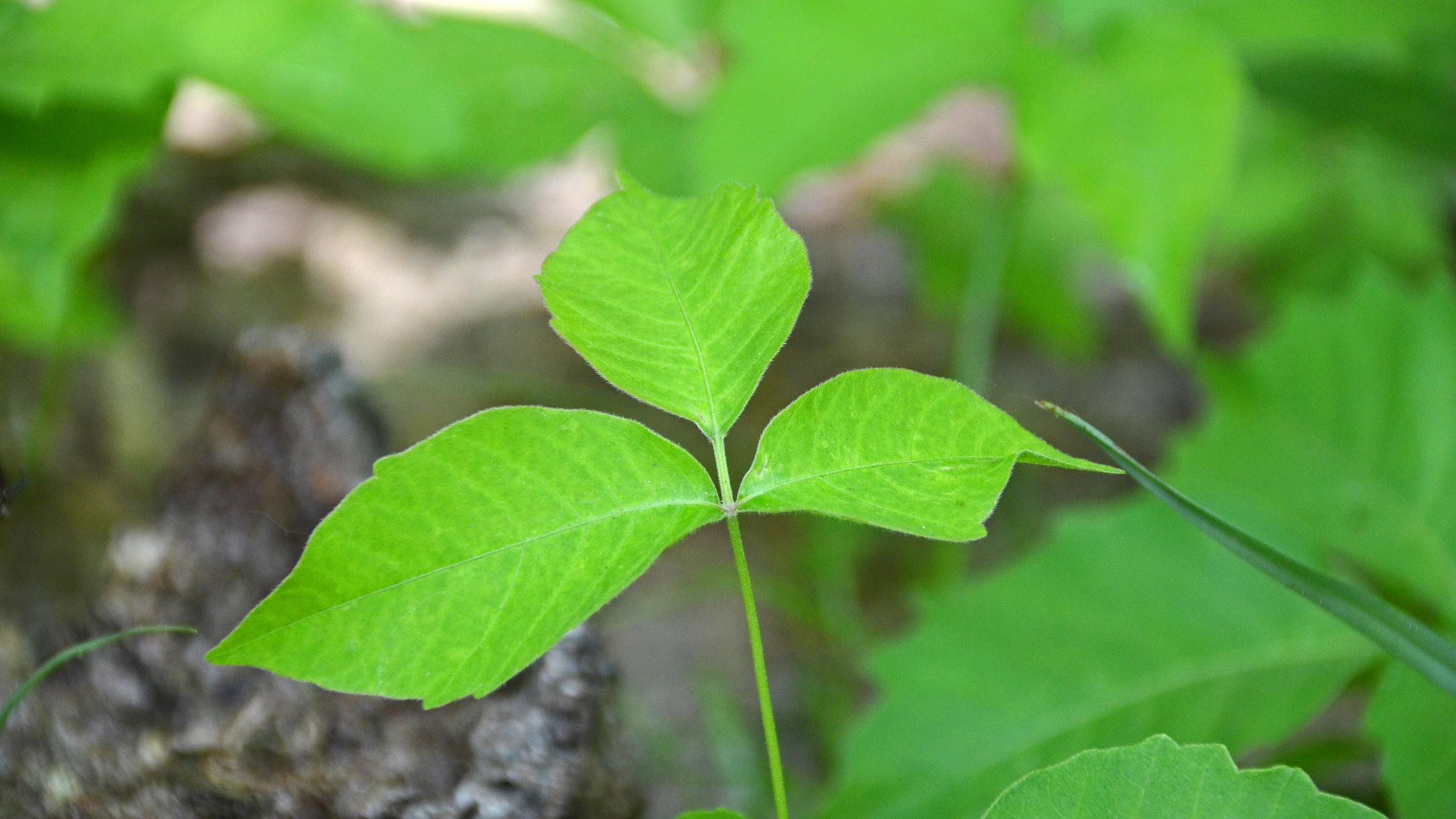
Poison ivy. Photo © Lisa Ballard Don’t kid yourself. According to the American Academy of Dermatology, about 50 million people get the rash each year, making it one of the most-common allergies in the United States.
If you don’t get it the first time you touch it, you will probably get it the second time. Unfortunately, the body doesn’t build immunity. On the contrary, the more times you are exposed to it, the worse the break out. The rash may appear in only a couple of hours on veteran poison ivy sufferers. Among first-timers, it can take up to 10 days.
Urushiol oil binds to the skin in 20 minutes or less, and it’s concentrated stuff. Only one nanogram can trigger the rash. (The average human exposure is around 100 nanograms.) But there’s hope! If you know you’ve touched poison ivy and you immediately wash the exposed area with soap and water, your odds of getting the rash greatly decrease.
If you think a large area of your body may have touched it, take a shower, not a bath. The oil can rise to the top of your bathwater and get on more of your body. If you’re in the backcountry, rinse the area in moving water. Don’t forget to wash your clothes and gear, too.
-
Myth #5: When poison ivy dies, it can’t cause the rash.
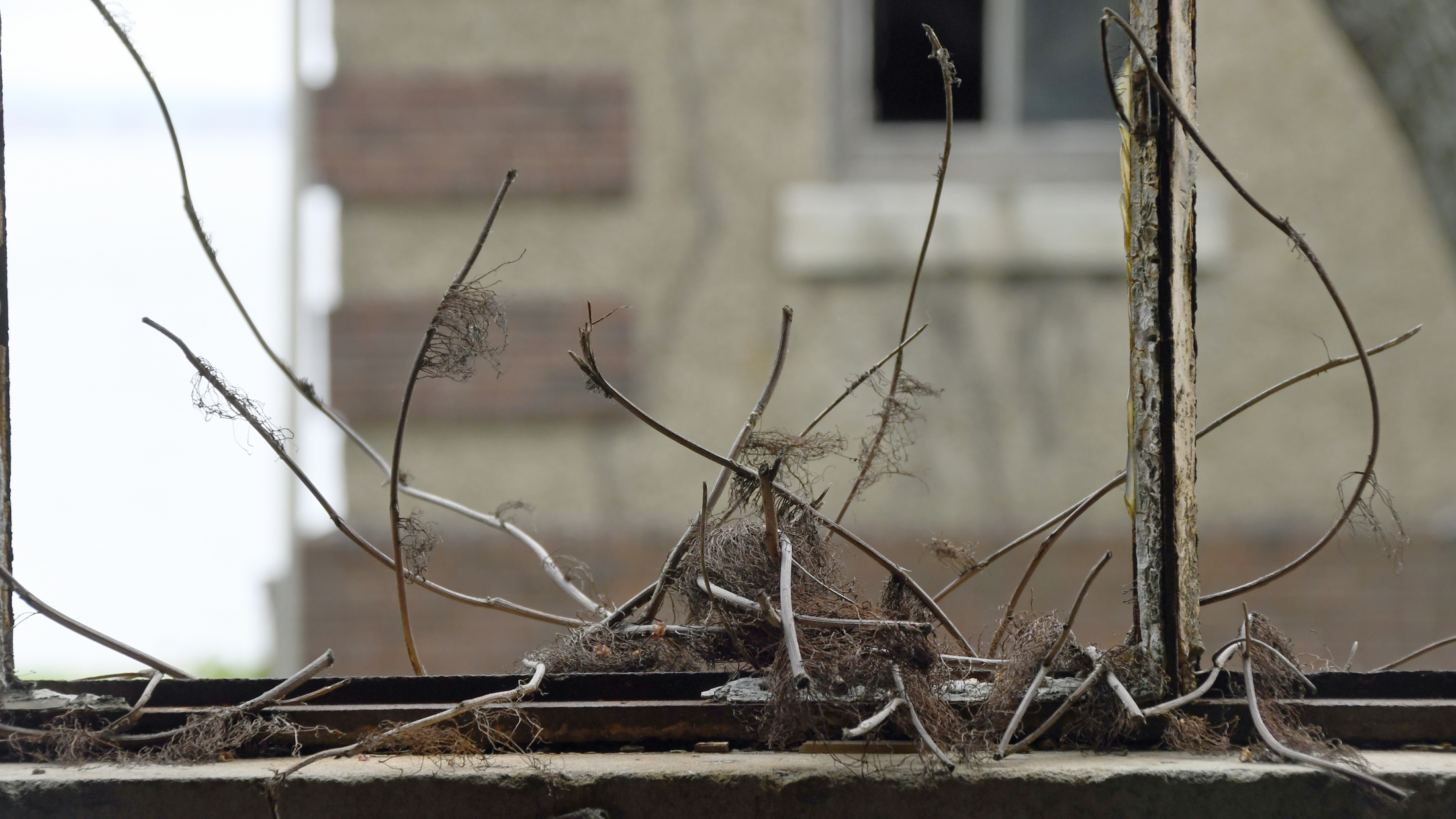
Poison ivy vine on window. Photo © Lisa Ballard Urushiol oil is durable stuff. While the plant won’t produce more of it after it dies, the oil can linger for five or more years. You’ll need a quick trip to the emergency room if you unwittingly burn it in a pile of dead wood, inhaling the smoke, which can carry urushiol oil into your lungs. This nasty toxin can also become airborne from wildfires and lawnmowers.
-
Myth #6: Climate change has no impact on poison ivy.
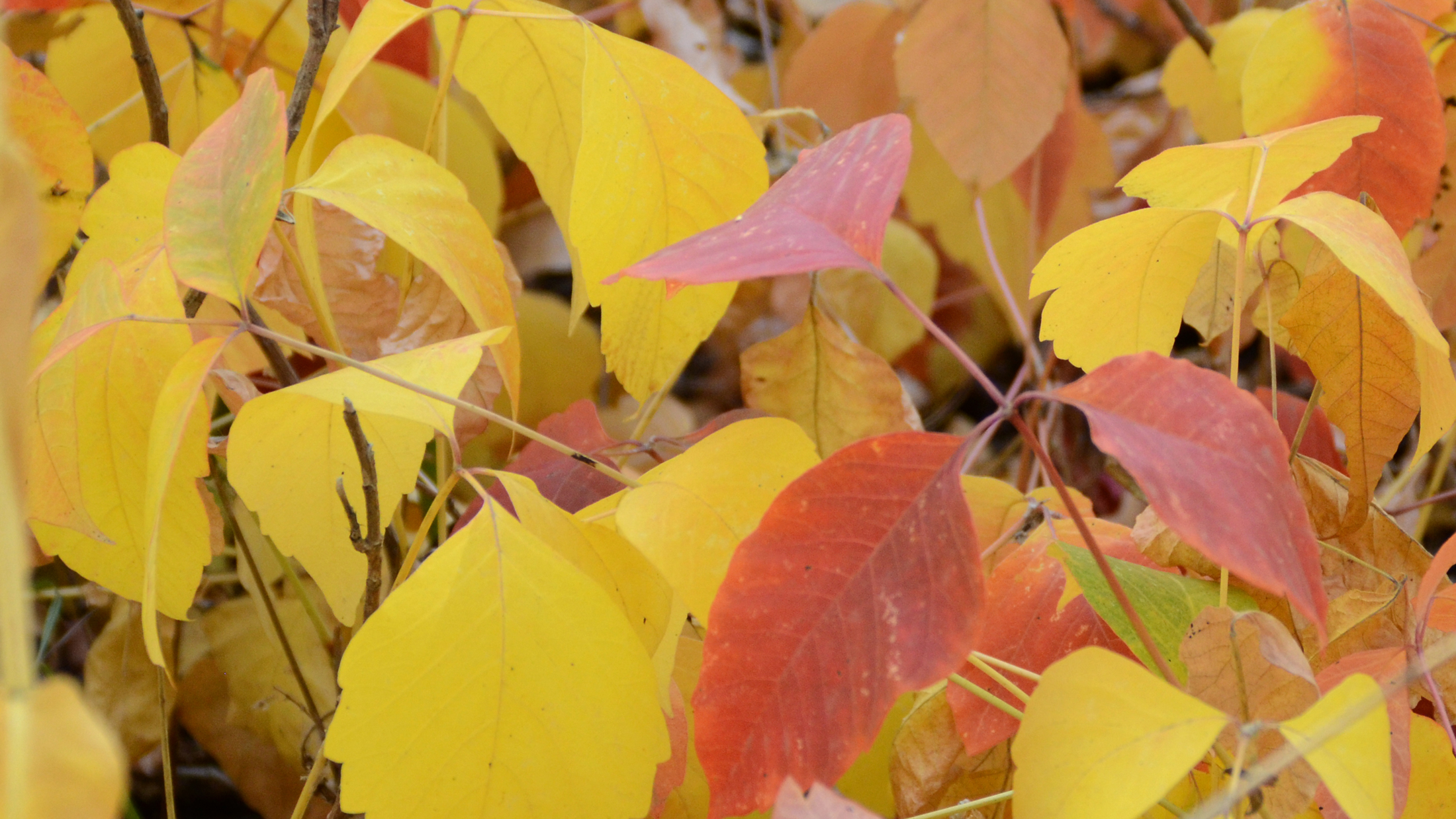
Poison ivy. Photo © Lisa Ballard Historically, backcountry travelers believed they were safe from poison ivy at elevations above 2,500 feet in the East and 4,000 feet in the West, and in desert climates. However, I live at 5,500 feet in the Beartooth Mountains near Yellowstone National Park and see it when I hike. I’ve also seen it in the arid Grand Canyon after a rare, heavy rain storm caused dormant poison ivy to emerge on sandbars.
Poison ivy is creeping higher and drier, but perhaps more unsettling is the fact that it’s getting more potent. According to a 2006 study published by the U.S. Department of Agriculture in Proceedings of the National Academy of Sciences, poison ivy leaves are increasing in size and are coated with more and stronger urushiol oil as levels of carbon dioxide increase globally.
I don’t mean to be an alarmist, just more observant. Whether doing yard work, jogging down a country lane or trekking in the mountains, you can bet I’ll be checking the flora before blithely blundering through it.
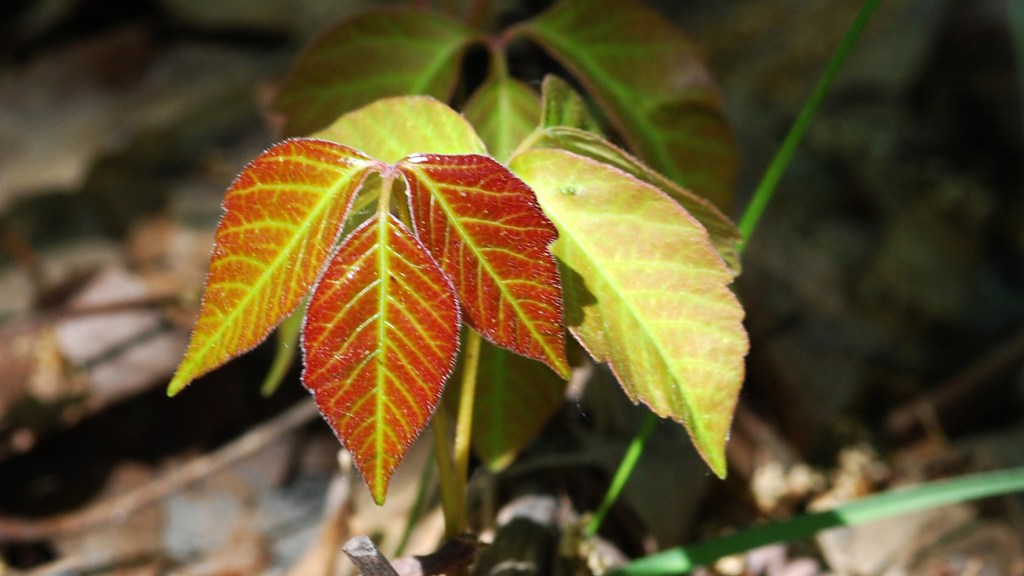



I recall that some 70 years ago when i was a camper at an overnight camp for girls, i was very homesick. I decided that the best way to get home was to rub poison ivy leaves all over (and i do mean all) my body. In 2 days I was covered, head to toe, and everywhere in between, with itchy, weepy pustules. Did that get me sent home from camp? On the contrary, I ended up in the camp infirmary for a week. I am 81 years old and can recognize poison ivy immediately, and I stay far away from it!
I’ve gotten poison ivy as long as I can remember. I would even get yearly shots as a child. But that would just slow it down. I would get it the same time every year. I would not go in woodland areas just for that reason and I would get it from the dog. Now I know exactly what it looks like and I love to hike and out door activities so I dress for it, watch for it and wash after it. Believe me it will find you and you won’t like.
I once got it on my thighs and butt from walking around the woods naked. I didn’t wear a bikini that Summer! I had to use plenty of lotion. Even though I still like to explore the forest in the nude, I’m more careful now.
Dandruff shampoos work better than plain soap and water and better than the expensive poison ivy washes. Rub it on your skin where you’ve been exposed to the oil, let it dry for a while, then wash it off. This works really well especially if you do it soon after exposure. Homeopathic remedies can be used as preventatives and treatment. They’ve completely changed my life, as I no longer have to worry about poison ivy. I used to get it as bad as second degree burns. The homeopathics have actually helped me build up immunity, and I rarely get more than a very mild rash if anything at all.
Claiming that the following is a myth is misleading: “If you don’t see three leaves, it’s not poison ivy.”
If we read the whole section under that, we will understand what you mean.
However, I recommend that the myth title be corrected, because, reading the title alone, people will think that perhaps a plant with five leaf sets, for instance, could be poison ivy.
Back when the world was young I contracted poison ivy rash. My mother, using the old open top washing machine, had me plunge my forearms into the bleached water. It seemed to make the rash go away, as I recall. I was but 5 or 6.
Years later, my son was stricken, his eyes swelling until I told him, “You look like Garfield The Cat!” Any ‘infection’ that near the brain can be very threatening.
A prescription for prednisone, a steroid, cost $1.98 cents, and gave him relief.
I’m anti-chemical poison on my property, but poison ivy gets an exemption. I use an ivy-kill spray which alleges to absorb on the sprayed leaf and go to kill the roots. The roots are well-developed and persistent, possessed of the wonderful tenacity of plant life, but some control is possible.
The news that the increased carbon put in the ambient air by the human phenomenon of the last 169 years, The Industrial Revolution (1850), where Homo Sapiens, ‘knowing man’, evolved into Homo Ignitius, ‘burning man’, is causing evolutions in living things should not have surprised me. I read somewhere a fungus, usually only found in laboratories, has escaped into the wild and is expanding its survival region north and south of the equatorial climes, thanks to atmospheric heat retention. The ‘human phenomenon’ went from one-billion ‘knowing men’ all alive, all at the same time in 1850, to seven-plus billion all alive, all at the same time, and burning anything that will burn, in exponential increases, over the last 169 years. In just seventy-five years there were two-billion (1850-1925). Just thirty-seven years to three-billion (1962). Just fourteen years (1976) to four-billion, ten years (1986) five-billion. ‘They’ have quit talking about it so numbers are harder to come by in 2019.
Global climate disruption is a Threatening Change, capital T, capital C, and demands humans enact tactics in a strategy of Adaptive Response to enable survival of living things, including humans. You don’t have to debate Cause and Effect. The Effect IS happening, and demands Adaptive Response.
Finding Leadership Decision-Makers in commerce and government possessed of the intellect and integrity (It demands both!) to plan and enact those tactics is proving to be problematic. Those who have their money invested in continuing man’s ‘Mine! All mine!’ burning-behavior about planet Earth’s resources are resistant to Adaptive Response. Interestingly, those entities are the best equipped to make the Adaptation, financially, and whose survival motive should be on the minds of their Leadership Decision-Makers. Fossil fuelers could preserve their resources to supply human demands far further into the future, for uses we can’t readily Adapt away from.
If Mother Nature shines the Sunstar, capture that energy. Mother Nature’s nuclear wastes are ‘safely’ kept at the site of energy generation, 93 million miles away. If Mother Nature moves her air or water, capture that energy. Oceans and rivers are in constant motion. Mother Nature’s already made the investment. There is geo-thermal energy in the ground at your feet, wherever you are.
Meanwhile, poison ivy is burning man’s harvest, larger leaves, more and more potent urushiol oil. What else is happening to living things in Adaptive Response to increased carbon dioxide? The oceans are acidified, meaning every plant and animal living there lives in an acidic environment. Cancer grows in the absence of oxygen, and acid chases oxygen out of living tissues. Capital T, capital C.
Good to know!!
I destroy pison ivy when I see it with disposable gloves!!
Thank you for this insight most informative!
Note: California should be included on the list of states where poison *ivy* does *not* grow: There are no confirmed sightings of it within the state, per Calflora (calflora.org), the clearinghouse for plant observations. We do have lots and lots of poison *oak*, though.
the wild plant Jewel weed is THE ANTIDOTE to poison ivy rashes. it actually grows right among poison ivy. if a leaf of Jewel is held under clear water, it sparkles like aluminum foil, and doesnt get wet!
to use jewel weed, pull up A stalk from the ground and give thanks. in the stem and in the roots is a pretty clear mucilaginous fluid. Take the stem and gently smush it all over your rash getting the juice all around the area. if you even Think you came in contact w poison ivy, find some Jewel Weed and use as directed above to prevent the rash!
lastly, one can get infected w poison ivy even in the snow!!
BgBrooks
A word of caution when washing off poison oak. My husband pulled some poison oak out of our back yard and afterwards threw his clothes in the washing machine and took a cool shower. Unfortunately, he used deodorant soap and not Fels Naptha (sp), which only spread the oil over more of his skin. After our nap I developed a hand imprint rash on my thigh, and you could see imprints of his fingers on his legs. I don’t know if I am especially sensitive or allergic to Calamine lotion, but my case developed so severely that my doctor had to put me on Prednizone .
We used to have poison ivy the size of gorilla arms, really. My husband was trying to rip them from our
trees in the back yard, by swinging on them. Alas, he got a very bad case of poison ivy. He did not do
that again.
I was wondering if the plant produces any berries that look like a raspberry? And, does the plant have
thorns?
Thanks.
Poison ivy berries are white. The plant has no thorns.
Do deer commonly eat poison ivy?Since it is a native species , I hate to eradicate it. However, deer are short on food where I live.
Thanks for the details. Poison ivy is truly awful if it gets on your skin ,or under your arms or on your neck. Be really cautious if you’re sensitive.
We will be in Montana in October, and will go walking. It might have a frost in Sept. does it go dormant after a frost, or should we stay on the path while walking?
You didn’t mention mosquitoes injecting the poison ivy into you. That is usually the only time I get poison ivy.